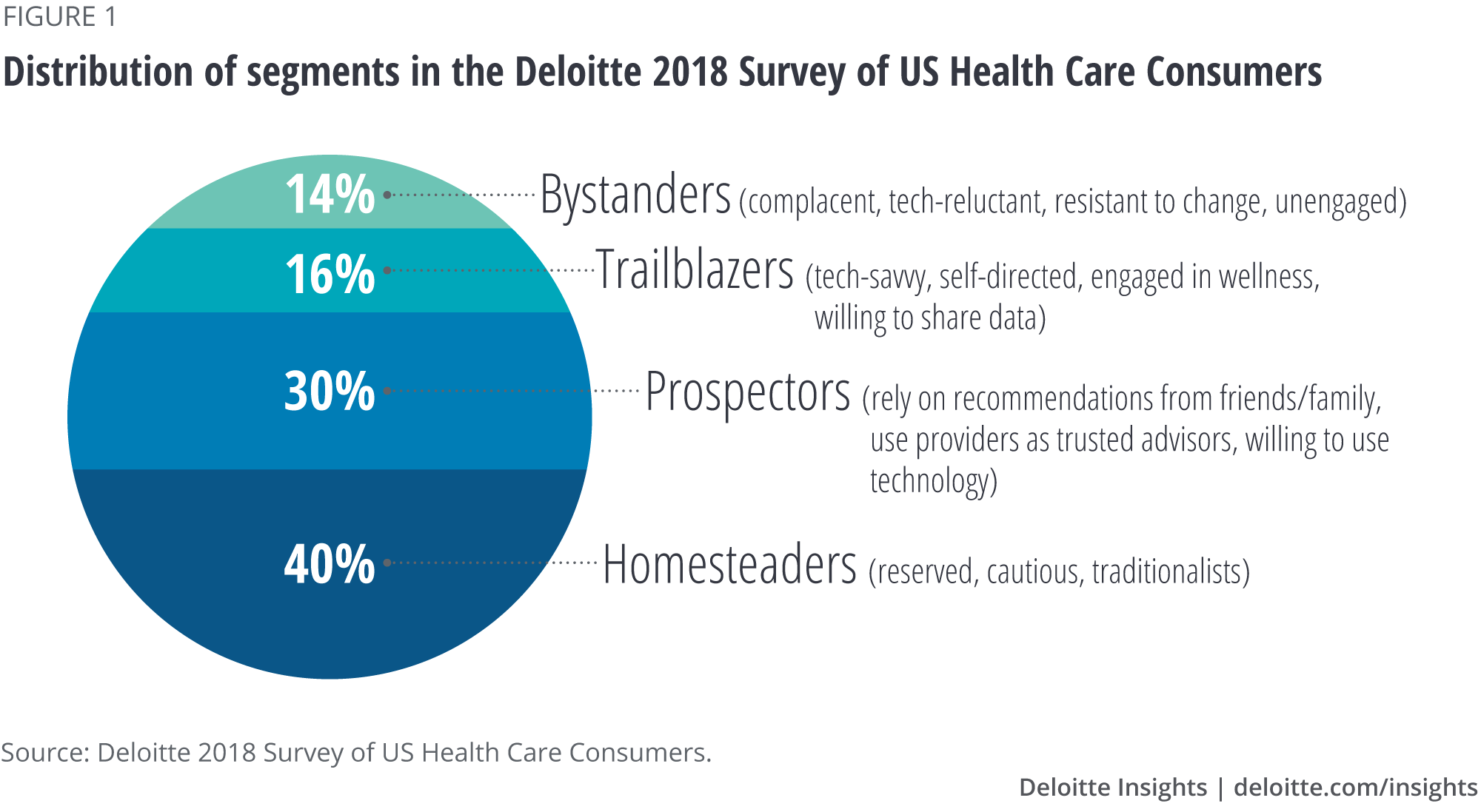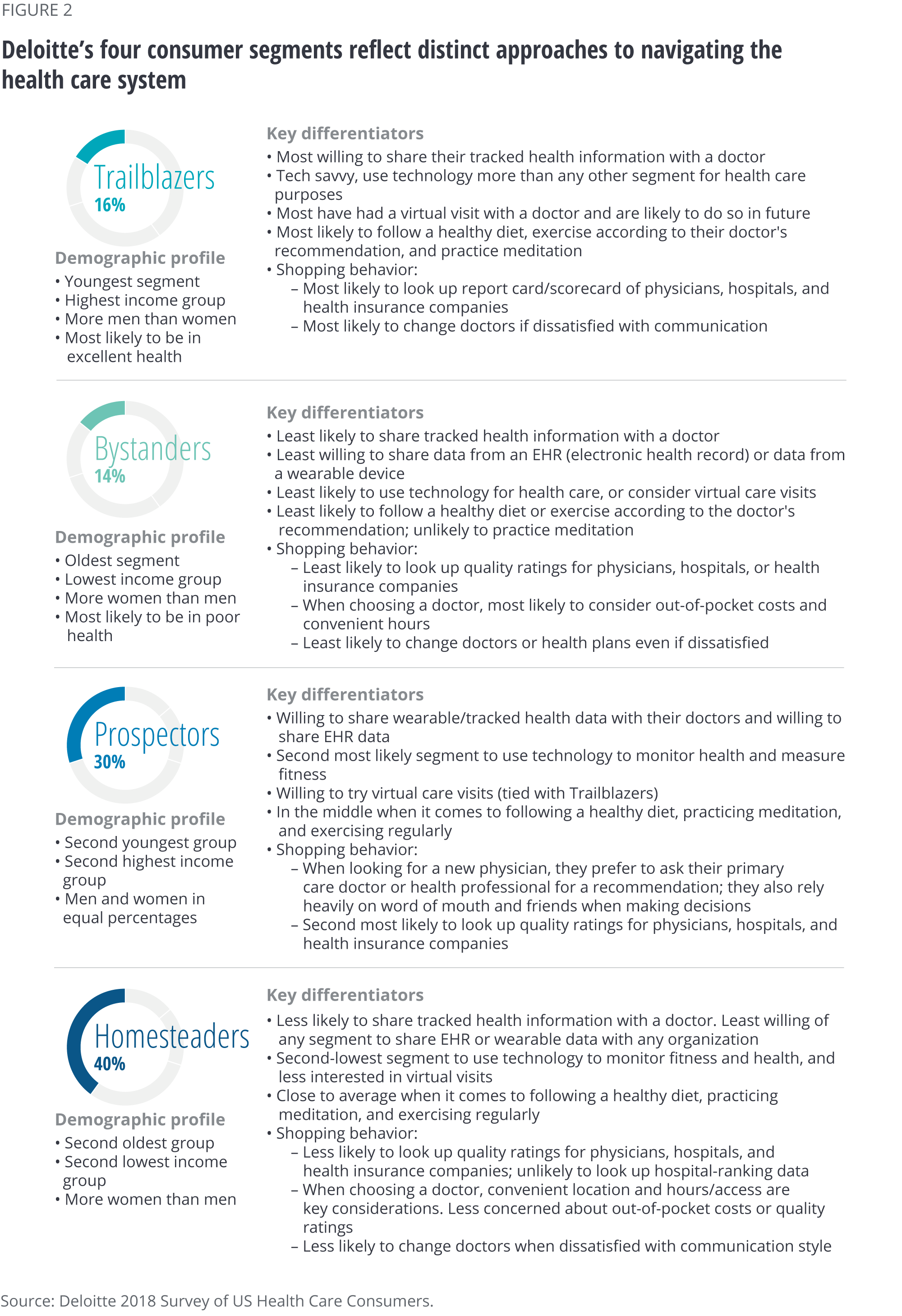
How do consumers navigate the health care frontier? Segmentation analysis helps health care stakeholders understand attitudes and behaviors to attract, retain, and engage consumers
29 October 2018
Health care consumers’ preferences appear to be changing. Health care providers, health plans, and life sciences companies can use novel approaches to segmentation to better target, attract, and retain consumers.
A deeper understanding of consumers’ decision-making processes can equip health care stakeholders to better retain and engage them as well as attract new ones. With this in mind, the Deloitte Center for Health Solutions recently surveyed 4,530 US consumers to assess their attitudes, behaviors, and preferences when making decisions about health insurance, health care, and well-being. A segmentation analysis of this data, focusing on health care attitudinal and behavior questions rather than demographics, offered us a far richer understanding of consumers than analysis focused solely on demographics.
Learn More
Explore the 2018 surveys of US health care consumers and physicians
Visit the Health care collection
Subscribe to receive related content from Deloitte Insights
The analysis results categorized individuals into four distinct groups that reflect their differences in preferences for managing their health and interacting with various health care stakeholders (figure 1). Given its changing—and sometimes unknown—landscape, the US health care system draws parallels with the Wild West of the 19th century. We therefore used personalities of individuals from the American frontier during that time period to describe the results of our segmentation as follows:
- Trailblazers (tech-savvy, self-directed, engaged in wellness, willing to share data)
- Prospectors (rely on recommendations from friends/family, use providers as trusted advisors, willing to use technology)
- Homesteaders (reserved, cautious traditionalists)
- Bystanders (complacent, tech-reluctant, resistant to change, unengaged)

Our analysis showed that each of these four groups has unique needs and expectations and navigates the health care system differently (figure 2). Such segmentation can help health plans, health systems, clinicians, and life sciences companies tailor their interaction with consumers, whether they are looking for a new health plan, doctor, or support in dealing with a chronic condition—just to name a few examples. The report offers suggestions for interacting with consumers from each of the four groups.

Welcome to the health care consumer frontier
To help illustrate each of the consumer segments that emerged from our analysis, we created four fictional personas. Meet Ryan, Noelia, Devika, and Warren.
The Trailblazer (tech-savvy, self-directed, engaged in wellness)

Ryan is an avid cyclist and runner who recently ruptured his Achilles tendon during a pick-up basketball game with other overly competitive 30-year-olds. Although there is a hospital just three blocks from the recreation center, a quick internet scan turned up several negative reviews from former patients. Ryan identified a small suburban hospital on the other side of town that had excellent scores. His friends suggested calling an ambulance, but Ryan opted for the ridesharing app on his phone instead. While researching the injury during the ride, he determined that surgery would probably be needed, so he went to his insurer’s website to make sure the hospital was in-network. An emergency room doctor told him about the hospital’s new app that gives patients access to their medical records along with information about postoperative care. It also sends reminders to patients about upcoming virtual and in-person appointments. Ryan downloaded the app so that he could share health information with his regular doctor and with his new physical therapist. Ryan also likes the hospital’s virtual-care option because he travels quite a bit for work. He has had several online physical therapy appointments in his hotel room.
Three key behaviors of the Trailblazer
- Relies heavily on technology to make health care decisions, access care, and track health and wellness
- Is likely to use quality rankings, reviews, report cards, or scorecards for evaluating physicians, hospitals, and health insurance companies
- Will probably switch doctors if dissatisfied with communication
How can health care stakeholders try to connect effectively with the Trailblazer?
- Offer high-quality virtual office visits. Virtual visits are increasingly being covered by Medicare, Medicaid, and other health insurers. Health systems and health plans should make sure consumers are aware that virtual visits are an option, and should explain how to get started. Of the survey respondents who participated in a virtual visit, more than half said the health professional who delivered care was as knowledgeable as someone they would see in person.1 About a third of them said they got the information they needed through the virtual visit. Health systems should ensure that clinicians are trained to help patients transition from traditional to virtual care.2
- Create a seamless—and integrated—technology experience. Trailblazers are likely to use technology and are willing to share their health information to get better care. But they are also likely to switch providers or health plans if their needs and expectations are not met. Creating an easy and connected app/digital platform can keep the Trailblazer satisfied and build loyalty. Many consumers already use apps for shopping, booking travel, and managing finances. They tend to expect a similar experience when it comes to managing their health. Simplifying common activities—such as scheduling appointments, accessing personal health information, refilling prescriptions, and managing appointments—can enhance the patient experience. However, health care stakeholders should be cognizant that consumers have access to thousands of apps, some features of which could overlap. Stakeholders should look for opportunities to partner with each other to consolidate these solutions for a truly consumer-centric experience.
- Engage them in data collection initiatives. Of the four segments, Trailblazers are the most willing to share their personal data from wearables and apps as well as most likely to consider at-home genetic and diagnostic testing. This data can be harnessed to help health plans, pharmaceutical companies, and technology developers understand the consumer experience, identify unmet needs, and improve products and services.
The Prospector (relies on recommendations from friends/family, uses providers as trusted advisors, willing to use technology)

It has been nearly a year since Noelia and Nick rushed their six-year-old daughter to the emergency room. The pediatrician diagnosed her with asthma, prescribed an inhaler, and recommended a clinic that specializes in pediatric asthma. One of their daughter’s friends is also a patient at this clinic, and her parents have been happy with the level of care. While Noelia likes meeting with clinicians in person, the clinic is more than an hour’s drive away, and her daughter prefers meeting the doctor at home via her tablet. Noelia’s health plan covers both in-person and virtual visits. Noelia has also joined a Facebook group for parents of asthmatic children, and she finds it helpful to see how other parents manage the condition. She recently read about smart inhalers with a sensor that communicates with a smartphone app via Bluetooth and helps track her inhaler usage. This piqued Noelia’s interest because both she and the doctor could view the data and make sure her daughter is taking her medication correctly. She needs to check if this device is covered by her health insurance.
Three key behaviors of the Prospector
- Relies on recommendations from primary care doctors or other medical professionals
- Has a high regard for recommendations from friends and family
- Is interested in technology and willing to share tracked health information with doctors
How can stakeholders try to connect effectively with the Prospector?
- Tap into social and patient-advocacy groups. Prospectors rely on recommendations from trusted doctors, but they also seek input from friends and family. Organizations that build patient-focused technology solutions could build trust and reach more consumers by monitoring and participating in patient forums. Health systems, health plans, and life sciences companies should take advantage of online patient groups and social media sites to connect with and understand patient and caregiver concerns, gather feedback, and improve quality of care.
- Promote wearables. Clinicians can promote wearable fitness and health-monitoring devices to Prospectors who have certain conditions, as well as for prevention of new conditions. Since they are more likely than some other segments to use these technologies, there is an opportunity to reduce hospitalization and office visits. Life sciences companies could use these technologies to connect with chronically ill patients (with the patient’s consent) to show improvements in the long-term outcome beyond the episode of care.
- Leverage the patient–clinician relationship. Prospectors trust their clinicians, but can be skeptical of drug companies and insurers; stakeholders aiming to improve trust levels among Prospectors should demonstrate the value of their solutions to clinicians. Given that Prospectors are the most likely group to adhere to a treatment regimen, physicians should take the time to discuss treatment options, prescription regimens, and behavior change.
The Homesteader (reserved, cautious, traditionalist)

Devika is a married 50-year-old manager of a downtown retail store. She tries to eat healthy and exercise, but with two children in high school, she often doesn’t have time to go to the gym and lunch tends to be takeout. She is overweight, has diabetes, and has been seeing the same physician since she started her job six years ago. The doctor’s office is just two blocks away and offers evening appointments once a week. She doesn’t always agree with her doctor or understand the prescribed treatment, but is reluctant to look for someone new. She gets health insurance through her job, and chose her health plan over two other options because an in-network medical practice was close to work. The premiums are higher, but Devika sees value in convenience. Her doctor suggested she wear a device that can track her glucose levels and transmit the information to the office, but she is comfortable neither with the device nor with sharing personal information. She doesn’t mind the idea of virtual care, but for now she prefers meeting with her doctor and the physician assistant in person. The stress of balancing her home life and job and managing her diabetes sometimes leaves her feeling depressed. She thinks this is probably normal and doesn’t want to ask her doctor about it.
Three key behaviors of the Homesteader
- Not as concerned about out-of-pocket costs or quality ratings as the other groups. Will make decisions based largely on convenience (for example, location and hours/access)
- Unlikely to currently use virtual care or technology to monitor health, but is somewhat interested in using it in the future
- Does not have a strong wellness/prevention routine at home, but is a high utilizer of primary-care visits
How can stakeholders try to effectively connect with the Homesteader?
- Offer more convenient appointments. Health systems and physicians can make accessing health care more convenient for Homesteaders by offering off-hour appointments (for example, evening or early morning hours on certain days).
- Collaborate with patients on treatment options. Rather than telling consumers what to do, clinicians and other caregivers should engage them in shared decision-making on treatment options and strategies to improve healthy behaviors. Homesteaders can become overwhelmed by or confused about how to manage a chronic condition. Offering a nurse call-line facility or encouraging them to check in with a care team member via email or telephone could help avoid unnecessary emergency room visits.
- Use care assistants and case managers to engage patients and potentially technology. The Homesteader wants a human connection, but is not completely opposed to using technology. But even those potentially willing to use a glucose monitor or virtual care/app for mental health services, for instance, could need some extra help. For example, a nurse or clinician could take five minutes at the end of an appointment to help set up a virtual mental health visit instead of expecting them to do it on their own. Homesteaders can benefit from a health coach who teaches them how to use tools, technology, or digital platforms and solutions that can easily be embedded into their everyday life. Stakeholders should coordinate and partner in offering support services, as multiple care coordinators from various stakeholders could be confusing.
- Enhance member experience. Health plans have a unique role to play in the health care ecosystem. They can help improve consumers’ experience through the care management programs and services most plans have in place. For example, consumers like Devika may prefer working with a health coach through their care management program rather than monitoring their condition through a wearable.
The Bystander (complacent, tech-averse, resistant to change, not engaged in wellness/prevention)

Warren is a 71-year-old retired high school teacher with a Medicare supplemental policy. While most of the premium cost is covered by the school system, he has heard that budget reductions might result in cuts to retiree benefits. He hopes his son will sign him up for similar coverage if that happens. Warren has been with the same carrier for the last six years and hasn’t had any problems with his health coverage.
Although he hasn’t been to a doctor in two years, he is pretty sure his cholesterol level is too high. During his last visit, his doctor wrote prescriptions for drugs to bring his cholesterol and blood pressure under control, but Warren stuffed the prescriptions in a drawer and forgot about them. He worries about the potential side-effects of the drugs and is not willing to alter his diet. Warren knows he is overweight, but other than walking his dog, he doesn’t exercise. He has a computer that his son gave him as a birthday present, but he only uses it to look at pictures of the grandkids. He is not interested in learning how to navigate the internet.
Three key behaviors of the Bystander
- Highly unlikely to use technology for health care (for instance, monitoring conditions, virtual visits, refilling prescriptions online, medication reminders)
- Generally doesn’t trust the health care system, and is not interested in quality ratings or in sharing personal information to improve health. This group is also least trusting of any source of information about effective treatments
- Resistant to changing health behaviors, and typically is unwilling to switch providers or health plans, even when dissatisfied.
How can stakeholders try to effectively connect with the Bystander?
- Involve a caregiver. Bystanders are unlikely to engage with the health system on their own; so, one approach would be to offer services via a formal or informal caregiver (such as a home nurse, a family member, or a friend or advocate) who could encourage Bystanders to engage in their health.
- Leverage the community. Bystanders might respond to messages from community organizations that they interact with regularly (for example, churches, grocery stores, or barber shops). Such messages might encourage them to get flu shots/vaccines at a community pop-up, get information about diabetes or stroke prevention from the local barber shop, participate in mobile screenings at their local grocery store, or partake in healthy eating education at church potlucks.
- Tailor solutions for unique barriers to medication adherence. Life sciences companies and physicians could work together to improve their understanding of what drives nonadherence in subpopulations. For example, is the patient averse to taking medication in general? Is there a perception that the therapy is not working? Are there cost barriers? Is the patient simply forgetting to take medication as prescribed? Strategies and interventions to improve adherence should be tailored accordingly.
- Treat the Bystander with respect. Since the Bystander is not as engaged as the other consumers, stakeholders might think they are not capable of understanding clinical information. But each interaction with a Bystander could be a high-value opportunity to engage with them. An in-person office visit could be an opportunity to spend additional time addressing their questions and concerns.
How well do you know health care consumers?
Every consumer makes decisions differently—whether deciding on which movie to watch, what type of car to buy, or where to stay or eat during a vacation. Consumers also have different approaches to determining which health plan offers the most appropriate coverage, when and where to seek care at a hospital, how to choose a doctor, and whether a pharmaceutical product or medical device offers value.
Our analysis provides insights into how attitudinal and behavioral segmentation can provide a more refined approach to understanding consumers across different stages of the patient journey. Organizations can use data beyond just demographics to identify which segment their population or consumers fall into—and thus better target, attract, and retain consumers.
To succeed in their consumer strategy, health care stakeholders should consider the following:
- Understand why certain consumers choose them, while others select a competitor or opt not to make a health care decision at all
- Determine which consumers to target, develop strategies to attract them, and determine how to retain them
- Help passive consumers become more engaged in the health care system so that they engage more efficiently and get greater value from the health care system
Appendix: Methodology
Segmentation of the Deloitte 2018 Survey of US Consumers
Since 2008, the Deloitte Center of Health Solutions (DCHS) has surveyed a nationally representative sample of US adults (18 and older) about their experiences and attitudes related to their health, health insurance, and health care. The national sample is representative of the US Census with respect to age, gender, race/ethnicity, income, geography, and insurance source. As part of this effort, in February and March 2018, DCHS conducted an online survey of 4,530 US adults.
Using the 2018 consumer survey data, we selected 158 of the 347 variables to use in a segmentation analysis. Broadly speaking, these 158 variables fit into 12 themes:
- Technology use
- Adoption and willingness to use virtual care
- Wellness and prevention behavior
- Health care utilization
- Willingness to share personal health information/data
- Self-efficacy
- Views on health care affordability
- Important factors when choosing a doctor
- Customer service
- Trusted sources of information
- Health care issues with which consumers want help navigating the system
- Purchasing/shopping behavior for health insurance plans
After exploring multiple approaches, we used a K-Means approach which resulted in a four-cluster solution.
© 2021. See Terms of Use for more information.





